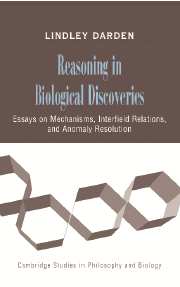 Reasoning in Biological Discoveries
Reasoning in Biological Discoveries Published online by Cambridge University Press: 31 August 2009
INTRODUCTION
Interactions between different areas or branches or fields of science have often been obscured by current emphasis on the relations between different scientific theories. Although some philosophers have indicated that different branches may be related, the actual focus has been on the relations between theories within the branches. For example, Ernest Nagel has discussed the reduction of one branch of science to another (1961, Ch. 11). But the relation that Nagel describes is really nothing more than the derivational reduction of the theory or experimental law of one branch of science to the theory of another branch.
We, in contrast to Nagel, are interested in the interrelations between the areas of science that we call fields. For example, cytology, genetics, and biochemistry are more naturally called fields than theories. Fields may have theories within them, such as the classical theory of the gene in genetics; such theories we call intrafield theories. In addition, and more important for our purposes here, interrelations between fields may be established via interfield theories. For example, the fields of genetics and cytology are related via the chromosome theory of Mendelian heredity. The existence of such interfield theories has been obscured by analyses such as Nagel's that erroneously conflate theories and fields and see interrelations as derivational reductions.
The purpose of this chapter is, first, to draw the distinction between field and intrafield theory, and, then, more importantly, to discuss the generation of heretofore unrecognized interfield theories and their functions in relating two fields.
To save this book to your Kindle, first ensure [email protected] is added to your Approved Personal Document E-mail List under your Personal Document Settings on the Manage Your Content and Devices page of your Amazon account. Then enter the ‘name’ part of your Kindle email address below. Find out more about saving to your Kindle.
Note you can select to save to either the @free.kindle.com or @kindle.com variations. ‘@free.kindle.com’ emails are free but can only be saved to your device when it is connected to wi-fi. ‘@kindle.com’ emails can be delivered even when you are not connected to wi-fi, but note that service fees apply.
Find out more about the Kindle Personal Document Service.
To save content items to your account, please confirm that you agree to abide by our usage policies. If this is the first time you use this feature, you will be asked to authorise Cambridge Core to connect with your account. Find out more about saving content to Dropbox.
To save content items to your account, please confirm that you agree to abide by our usage policies. If this is the first time you use this feature, you will be asked to authorise Cambridge Core to connect with your account. Find out more about saving content to Google Drive.